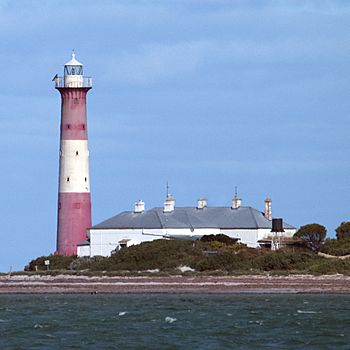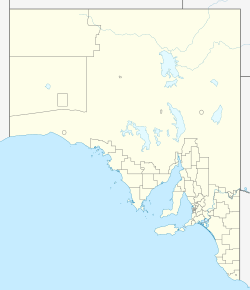Troubridge Island facts for kids

Troubridge Island Lighthouse
|
|
| Geography | |
|---|---|
| Location | Gulf St Vincent |
| Coordinates | 35°07′04″S 137°49′38″E / 35.11766°S 137.82733°E |
| Area | 2 ha (4.9 acres) |
| Highest elevation | 5 m (16 ft) |
| Administration | |
|
Australia
|
|
Troubridge Island is a small island in South Australia. It sits in the southwest corner of Gulf St Vincent, close to the town of Edithburgh. The island is famous for its old lighthouse, which worked from 1856 to 2002. It is also a very important home for many sea birds. Since 1982, Troubridge Island has been a protected area called the Troubridge Island Conservation Park.
Contents
About Troubridge Island
Troubridge Island is about 8 kilometers (5 miles) southeast of Edithburgh. It is a sandy island that always stays above the water, even at high tide. Plants help to keep the sand in place. In 1996, the island was about 2 hectares (5 acres) big and 5 meters (16 feet) high.
When the tide is low, the sandy area around the island stretches out for at least 1 kilometer (0.6 miles). It's easiest to reach the island by boat at high tide. This is when there is enough water over the sand to get to the dry land. Since 1988, you need a special permit to visit the island. These permits come from the Department of Environment, Water and Natural Resources.
Plants and Animals
Troubridge Island is home to many different kinds of plants and animals.
Island Plants
Most of the 31 types of plants found on the island were brought there by people. The island's plants are mostly low shrubs. These include nitre bush, grey saltbush, and African boxthorn. Other common plants are tree mallow, sea rocket, marram grass, and hairy spinifex.
Island Animals
The animals on Troubridge Island are mostly birds and reptiles. In 2009, nearly 60 types of native birds were seen there. This included 21 types that are important for conservation and 22 types that migrate.
Many birds live here, such as black-faced cormorants, Caspian terns, crested terns, and fairy terns. You can also find Pacific gulls, little penguins, pied cormorants, and silver gulls.
In 1996, there were about 10,000 starlings on the island. Starlings are not native to Australia. They were competing with native birds for places to rest.
Two types of reptiles have been seen on Troubridge Island. These are marbled geckos and sleepy lizards.
Little Penguin Colony
Troubridge Island has a colony of little penguins. In the 1980s, there were about 3,000 to 5,000 penguins. In 2009, about 3,010 adult penguins were breeding there. By 2011, the number seemed steady. However, a count in 2013 showed a big drop to only 270 breeding adults. Scientists are still trying to understand why this happened.
Island History
European Discovery and Use
Matthew Flinders found the Troubridge Shoals on April 1, 1802. However, he did not report seeing the island itself.
A lighthouse was built on the island to help ships avoid crashing on the dangerous Troubridge Shoals. This lighthouse, called the Troubridge Island Lighthouse, first lit up in 1856. It started working automatically in 1981. Its job of guiding ships was slowly taken over by a new lighthouse. This new lighthouse was built on Troubridge Hill on Yorke Peninsula. The Troubridge Island Lighthouse was turned off in 2001.
In 1981, the island was sold to the South Australian Government. They then created the Troubridge Island Conservation Park. The land where the lighthouse stood was leased by the Australian Maritime Safety Authority (AMSA). In 1993, this lease was given to the South Australian Government.
Troubridge Shoals
Troubridge Island is part of the Troubridge Shoals. These are shallow areas that stretch towards Yorke Peninsula. They are very dangerous for ships. More than 33 ships have crashed or run aground on the Troubridge Shoals. Between October 1849 and May 1850, at least seven ships got stuck. This is why the lighthouse was built in 1855.
When the ship Parsee crashed on the shoals on November 13, 1838, the people who survived landed on Troubridge Island.
Marion Reef, which is south of Troubridge Island, was named after the ship Marion. This ship ran aground there in 1851.
Protected Status
Official Protection
Troubridge Island has been part of the Troubridge Island Conservation Park since 1982. In 1986, the park was made bigger. It now includes about 1 kilometer (0.6 miles) around the island. This covers most of the sandbar that the island is part of. Since 2012, the island has also been inside the Lower Yorke Peninsula Marine Park.
Important Bird Area
The island and some of its nearby sandbar are named an Important Bird Area (IBA). This is a special area for birds, chosen by BirdLife International. It is important because it is home to more than 1% of the world's population of black-faced cormorants (up to 4,000 birds). It also has up to 10,000 breeding pairs of silver gulls. The island also supports many fairy terns, which are a vulnerable species.



